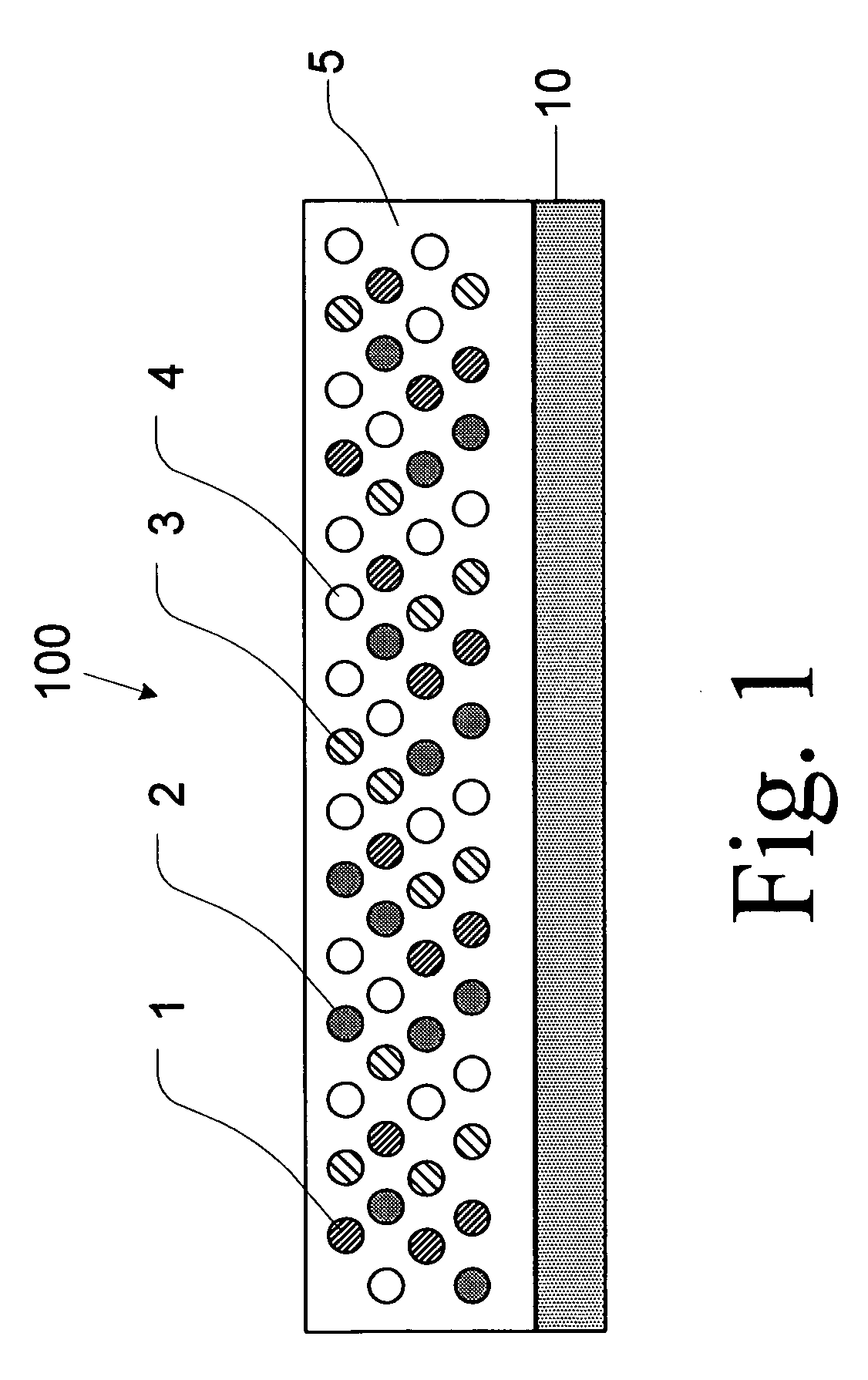Silicone photoluminescent layer and process for manufacturing the same
- Summary
- Abstract
- Description
- Claims
- Application Information
AI Technical Summary
Benefits of technology
Problems solved by technology
Method used
Image
Examples
example 1
[0072] About 0.5% by weight of SO400 was added to DC76570 based on 100% by weight of DC76570 to prepare a liquid silicone resin. The addition ratio of the above SO400 additive may vary depending upon progress conditions. The liquid silicone resin was mixed with about 13% by weight of (Y, Gd, Ce)3 (Al, Ga)5O12 (Daejoo Electronic Materials Co., Ltd., Korea) and Y3Al5O12:Ce (Phosphor Technology Ltd., England) as phosphors, and about 13% by weight of SiO2 beads having a diameter of about 5 to 7 μm as a diffusing agent, based on 100% by weight of the liquid silicone resin. Thus, the weight of the SiO2 is about the same as the weight of the diffusing agent. This mixture was stirred into a liquid silicone mixture using a rotating / revolving stirrer.
[0073] Then, the liquid silicone mixture was applied on a printing surface, such as the first layer of a PET film having a bilayer structure in which the first layer has a thickness of about 25 μm and the second release layer has a thickness of ...
example 2
[0075] Grid patterns were formed on the surface of a photoluminescent diffusion layer in the following manner. About 0.5% by weight of LS4326A and about 2% by weight of LS4326C were sequentially added to LS4326 based on 100% by weight of LS4326 to make a liquid silicone resin. The addition ratio of the above additives may vary depending upon progress conditions. To satisfy conditions for producing grid patterns on a printing surface, the liquid silicone resin requires viscosity of more than 3,000 cps. In this example, viscosity was adjusted to about 5,000 cps using toluene and the mesh size of the printing plate was about 20. When the viscosity of the liquid silicone resin is less than 3,000 cps, it is difficult to achieve smooth formation of grid patterns. Thus, viscosity is an important factor for the formation of grid patterns. The liquid silicone resin prepared above was mixed with about 13% by weight of (Y, Gd, Ce)3 (Al, Ga)5O12(Daejoo Electronic Materials Co., Ltd., Korea) and...
example 3
[0079] Optical properties of photoluminescent diffusion layers were compared utilizing various kinds of diffusing agents. About 0.5% by weight of LS4326A and about 2% by weight of LS4326C were sequentially added to LS4326 based on 100% by weight of LS4326 to make a liquid silicone resin. In this example, viscosity was adjusted to about 5,000 cps using toluene and a mesh size of a printing plate was set to about 120. The liquid silicone resin thus prepared was mixed with about 13% by weight of (Y, Gd, Ce)3 (Al, Ga)5O12 (Daejoo Electronic Materials Co., Ltd., Korea) and Y3Al5O12:Ce (Phosphor Technology Ltd., England) as phosphors, without a diffusing agent, and about 13% by weight of SiO2 beads having about 5 to 7 μm diameter, a PMMA monomer beads having a diameter of about 5 to 7 μm and a PMMA polymer beads having a diameter of about 5 to 7 μm as diffusing agents, respectively, based on 100% by weight of the liquid silicone resin. The resulting liquid silicone mixture was stirred usi...
PUM
| Property | Measurement | Unit |
|---|---|---|
| Diameter | aaaaa | aaaaa |
| Transmittivity | aaaaa | aaaaa |
| Weight | aaaaa | aaaaa |
Abstract
Description
Claims
Application Information
 Login to View More
Login to View More - Generate Ideas
- Intellectual Property
- Life Sciences
- Materials
- Tech Scout
- Unparalleled Data Quality
- Higher Quality Content
- 60% Fewer Hallucinations
Browse by: Latest US Patents, China's latest patents, Technical Efficacy Thesaurus, Application Domain, Technology Topic, Popular Technical Reports.
© 2025 PatSnap. All rights reserved.Legal|Privacy policy|Modern Slavery Act Transparency Statement|Sitemap|About US| Contact US: help@patsnap.com



